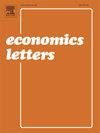寡头竞争中的拓扑混沌
IF 2.1
4区 经济学
Q2 ECONOMICS
引用次数: 0
摘要
本文运用Mitra的充分条件论证了寡头竞争可以表现出拓扑混沌。为了克服由于缺乏模态点的简单封闭形式表达式而引起的计算挑战,我们开发了一种基于结果的方法。结果表明,对于足够多的企业,一定存在保证拓扑混沌的参数值。本文章由计算机程序翻译,如有差异,请以英文原文为准。
Topological chaos in oligopoly competition
This letter demonstrates that oligopoly competition can exhibit topological chaos by applying Mitra’s sufficient condition. To overcome the computational challenges arising from the lack of a simple closed-form expression for the modal point, we develop a resultant-based method. Our results show that, for a sufficiently large number of firms, there must exist parameter values that guarantee topological chaos.
求助全文
通过发布文献求助,成功后即可免费获取论文全文。
去求助
来源期刊

Economics Letters
ECONOMICS-
CiteScore
3.20
自引率
5.00%
发文量
348
审稿时长
30 days
期刊介绍:
Many economists today are concerned by the proliferation of journals and the concomitant labyrinth of research to be conquered in order to reach the specific information they require. To combat this tendency, Economics Letters has been conceived and designed outside the realm of the traditional economics journal. As a Letters Journal, it consists of concise communications (letters) that provide a means of rapid and efficient dissemination of new results, models and methods in all fields of economic research.
 求助内容:
求助内容: 应助结果提醒方式:
应助结果提醒方式:


